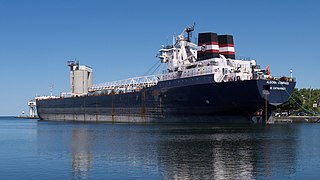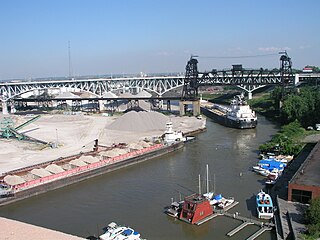
Lake freighters, or lakers, are bulk carrier vessels that operate on the Great Lakes of North America. These vessels are traditionally called boats, although classified as ships.
Quebecois was a lake freighter that served the Great Lakes, operating between ports in the United States and Canada. The vessel was launched in 1962 by Canadian Vickers Ltd of Montreal, Quebec, Canada. Used to carry grain and ore, Quebecois was built to the maximum dimensions allowed on the Saint Lawrence Seaway. The vessel entered service in 1963 and in 2012, the ship's named was altered to Algoma Quebecois. The ship was broken up for scrap at Port Colborne, Ontario, Canada in 2013.

Algoma Mariner is a Canadian lake freighter delivered to Algoma Central on 31 May 2011. The bulk carrier was the first new Canadian-flagged vessel on the Great Lakes in 25 years. Algoma Mariner is a Seawaymax vessel, designed to carry dry bulk through the Saint Lawrence Seaway and Great Lakes. The vessel was constructed at the Chengxi Shipyard in China and is currently in service.

MV Tim S. Dool is an Algoma Central-owned seawaymax lake freighter built in 1967, by the Saint John Shipbuilding and Dry Dock Co. in Saint John, New Brunswick. She initially entered service as Senneville when she sailed as part of the fleet of Mohawk Navigation Company. Senneville was the second lake freighter constructed with a single superstructure at the stern. In 1981, the ship was sold to Pioneer Shipping. That company sold the vessel to Algoma Central in 1994 who renamed the ship Algoville. The bulk carrier got her current name in 2008. Tim S. Dool is currently in active service on the Great Lakes of North America.

MV Algonorth was a Seawaymax lake freighter built in 1970 and completed in 1971 by the Govan Division of Upper Clyde Shipbuilders Ltd. in Govan, Scotland as the bulk carrier Temple Bar. Her original owners were Lambert Bros. Shipping Ltd., of London, United Kingdom, sold the vessel in 1976 to Nipigon Transport Ltd., who had her hull lengthened and installed a new power plant for Great Lakes service. Re-entering service as Lake Nipigon, the ship was renamed Laketon in 1984 before returning to the name Lake Nipigon in 1986. In 1987, the lake freighter was sold to Algoma Central Railway which gave the ship its final named, Algonorth. In 2007, the ship collided with a dock in Toledo, Ohio. The ship was scrapped in 2012.

Sauniere was a self-unloading bulk carrier operated by Algoma Central. Laid down as Bulknes, before launching the vessel's name was changed to Brooknes. The ship was constructed and completed in 1970. The ship was initially owned by the Swedish company Kristian Jebsens Rederi A/S. In 1974, Algoma Central purchased the vessel, registered the ship in West Germany and renamed it Algosea. Algoma Central sent the ship to Swan Hunter in England to be lengthened. Emerging in 1976, Algosea sailed for Canada for conversion to a self-unloading bulk carrier at Herb Fraser and Associates in Port Colborne, Ontario. Algosea, which transported road salt between ports in the Gulf of St. Lawrence, Saint Lawrence Seaway and Great Lakes suffered three collisions and two groundings during its career. The Algosea was renamed Sauniere in 1982 and continued in service until 2009 when the bulk carrier was sold for scrap and broken up in Turkey in 2010.
MS Windoc was a lake freighter or laker, initially constructed as an ocean-going bulk carrier in West Germany in 1959. Entering service that year as Rhine Ore, the ship was renamed Steelcliffe Hall in 1977 and reconstructed as a laker. In 1988 the laker was renamed Windoc and in 2001, was involved in a collision with a bridge on the Welland Canal which caused the ship to catch fire. The ship was declared a constructive total loss. While undergoing repairs in Ontario, the ship broke free of its moorings and grounded. Later pulled free, the vessel was eventually converted into a barge.

Algorail was a lake freighter owned and operated by Algoma Central. The ship was built by Collingwood Shipyards in Collingwood, Ontario and was launched in 1967. The ship sailed on the North American Great Lakes and the Saint Lawrence Seaway delivering coal/coke, aggregates, slag, iron ore/oxides, salt, fertilizers, grain products, gypsum, quartzite, or sand. The ship was laid up in 2016 and sold for scrap in 2018.

John B. Aird was a self-discharging lake freighter/bulk carrier that was launched in 1983 and served on the Great Lakes and Saint Lawrence Seaway until 2017. The vessel was owned and operated by Algoma Central during that time, which had named the vessel for a former chairman of the Algoma Central Railway. Prior to the construction of Algoma Equinox in 2013, John B. Aird was the last vessel built for the company.

English River was a lake freighter and bulk carrier, launched in 1961 by Collingwood Shipyards of Collingwood, Ontario. In her initial years she carried bulk cargoes and deck cargoes to smaller ports on the Great Lakes and Saint Lawrence River watershed and estuary. In 1973, the vessel was converted into a cement carrier and carried mainly raw cement for the construction industry. The ship continued to operate until English River was removed from service and sold for scrap.

Algolake was a self-unloading bulk carrier owned and operated by Algoma Central. The ship entered service in 1977 on the Saint Lawrence Seaway. In 1994, the ship ran aground in the St. Lawrence River off Quebec. The ship was laid up for scrapping in 2018, renamed Gola and was later scrapped in Aliağa, Turkey.

Algoma Progress was a self-unloading lake freighter and bulk carrier operating on the North American Great Lakes, owned by Algoma Central. Launched in 1968, the ship was originally named Canadian Progress and operated by the Upper Lakes Shipping. At launch, the ship was the largest self-unloading vessel on the Great Lakes. Canadian Progress was used to transport coal, iron ore, barley and road salt on the Great Lakes and Saint Lawrence Seaway. Canadian Progress ran aground twice, the first in 1985 and then again in 1988. In 2011, Upper Lakes Shipping sold its entire fleet to Algoma Central, which renamed the vessel Algoma Progress. In 2014, Algoma Progress was sold for scrap and broken up at Port Colborne, Ontario.

Algoma Compass, formerly Roger M. Kyes and Adam E. Cornelius, is a self-unloading bulk carrier built in Toledo, Ohio in 1973 for the American Steamship Company. The bulk carrier carried bulk cargoes throughout the Great Lakes and St. Lawrence Seaway. The vessel has earned a reputation as a "hard luck" ship, experiencing mechanical failures and groundings. In 2018, the ship was acquired by Algoma Central and put in service as Algoma Compass.

CSL Tadoussac is a lake freighter currently operated by Canada Steamship Lines (CSL) on the Great Lakes. She was launched in 1969. Initially named Tadoussac, following her refit in 2001, she was renamed CSL Tadoussac She was the last freighter built for CSL in the traditional two superstructure design, which puts her bridge up in the ship's bow. The vessel primarily transports iron ore and coal.

Algoma Buffalo, formerly Buffalo, is a diesel-powered lake freighter acquired by Algoma Central Corporation in 2018. This vessel was built in 1978 by Bay Shipbuilding Company at their yard in Sturgeon Bay, Wisconsin for the American Steamship Company and included self-unloading technology. The ship is 634 feet 10 inches (193.50 m) long and 68 feet (21 m) wide, with a carrying capacity of 24,457 tons deadweight (DWT), and is primarily used to ship road salt and construction goods. The vessel is currently in service.
Algogulf was the third and last name of a bulk carrier launched in 1961, laid-up in 1999, and scrapped in 2002. The ship began her career in 1961 as J.N. McWatters, the second vessel of that name operated by the Misener Shipping Company. The bulk carrier was used to transport primarily grain and iron ore in the Saint Lawrence Seaway and Great Lakes. In 1991, the vessel was renamed Scott Misener by the company, the fourth of that name. In 1994, the ship was acquired by Algoma Central and renamed Algogulf, the second vessel of the name. The ship was laid up in 1999 and sold for scrapping in 2002.

Radcliffe R. Latimer is a lake freighter launched in 1978. The vessel is owned by Algoma Central but operated under charter to Canada Steamship Lines from 1994 to 1997. As Algobay, the bulk carrier was involved in a collision with another lake freighter in 1980. In 2009 the vessel was rebuilt in China for service in the Caribbean Sea. The vessel is currently in service.

Algoma Provider was a Canadian lake freighter, which operated from 1963 to 2013 under the flag of several shipping lines. She was built to seawaymax dimensions at the Collingwood Shipyards in Collingwood, Ontario for Canada Steamship Lines. She was powered by a steam turbine, and was the company's last steam-powered vessel. Initially named Murray Bay, the ship was sold in 1994 to Upper Lakes Shipping, which renamed the vessel Canadian Provider. In 2011, Upper Lakes Shipping sold its entire fleet to Algoma Central, which renamed the lake freighter Algoma Provider. The vessel continued in service until 2013, when she was sold to be broken up for scrap. The ship was renamed Ovi for her journey to the scrapyard in Turkey. During her career, the ship carried bulk cargoes to destinations along the Saint Lawrence Seaway and Great Lakes.
Algoma Sault, which entered service in 2018, is the third freighter Algoma Central named after Sault Ste. Marie, Ontario. She is a self-unloading bulk carrier, built for carrying cargoes like ore, grain, or coal, on the North American Great Lakes and St. Lawrence Seaway. She is the seventh vessel of the Equinox class, and like her sister ships she was built in China.

Sedna Desgagnés is a Beluga E/F type cargo ship built in China from 2007 to 2009 and entered service with the Canadian shipping line Groupe Desgagnés in 2009. The television series High Arctic Haulers followed the vessel as she made the annual deliveries of supplies to a series of communities in Canada's Arctic Archipelago, during the short shipping season. The vessel also sails on the Great Lakes and St. Lawrence Seaway and is in service.
















